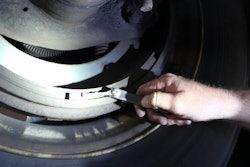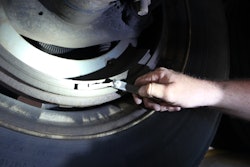Bobby Baker is proud to describe himself as a former truck driver, and he draws on that experience when discussing factors that affect clutch life. “It all comes down to that left foot,” says the technical director of Setco Automotive, which produces LIPE clutches. “You have some drivers called ‘cowboys’ and some drivers who know what they’re doing.”
It would be difficult to overlook the impact of that left foot, especially if a driver pits the power of a truck against the resistance of something like an ungreased fifth wheel. “The weakest part of the driveline is not the yoke. It’s not the driveshaft. It’s the clutch,” Baker continues. “The clutch is basically the failsafe so you don’t ‘puke’ a driveline or bust a gear.”
Beyond the issues that surround outright abuse, there is no overlooking the fact that clutches will require some level of maintenance support over time, and factors ranging from component choices to lubrication intervals will all play a role in the life of any design.
Mileage is actually a poor indicator when trying to determine the potential life of the clutch, notes Andreas Gebauer, senior design engineer with ZF’s Commercial Vehicle Group. The same facing material that lasts 200,000 miles in a linehaul truck could wear away within 50,000 miles under the pressures of a severe-duty application.
ASSESSING SERVICE
When it comes to ongoing maintenance, a series of detailed inspections will offer the best indication of service needs.
The initial adjustment of a new clutch begins by setting the proper gap between the rear face of a release bearing and the front face of the clutch brake that has been pushed into contact with the transmission. That gap should measure
530 thousandths of an inch (thous), plus or minus 30 thous, Gebauer explains.
While the existing Recommended Practice from the Technology & Maintenance Council (RP 638) specifically calls for a half inch, he is hoping that will be refined during a scheduled review of the document. Many widely distributed service manuals have already made the shift.
It is an important measurement. While some technicians believe they can improve the level of contact by reducing the amount of clearance, the decision can affect the pressure plate’s ability to retract, warns Vince Fuleki, product support manager for Roadranger Field Marketing. Drivers at the controls of such a clutch will begin to complain about the trouble they have getting into gear, and that could lead to an unnecessary replacement.
Meanwhile, one of the best ways to determine the need for an adjustment has traditionally involved using a tape measure to identify free pedal travel. If the amount of free play is within one inch of clutch pedal movement at the top of the clutch pedal stroke, an internal adjustment is needed. The locking mechanism may vary by manufacturer, but the clutch adjusting ring will have to be turned to compensate for the internal wear, re-establishing the original settings that existed when the clutch was first installed.
There are limits to the measurement of free pedal travel, however. The clutches found in a Volvo or Freightliner Cascadia will also be equipped with hydraulic actuators, which will mask any changes in free play. This is why self-adjusting clutches tend to be recommended for these systems.
The hydraulic systems will have maintenance needs of their own. Seals, for example, have been known to deteriorate when exposed to something other than a DOT-3 brake fluid.
But the nameplate-specific differences don’t end with hydraulic actuators.
When dealing with manually adjusted clutches, installers usually need to ensure there is 1⁄8 inch between the release fork tips and the clutch release bearing wear pads to allow for normal wear and movement. Adjustments actually are required once that gap shrinks to 1⁄16 inch or less. In comparison, Volvo equipment will not have any gap at all.
In a Peterbilt, International or Freightliner, meanwhile, the clutch fork reaches over the top of the throw-out bearing and rocks forward, Baker notes. With a Mack and Volvo, the fork comes from underneath.
Even the amount of recommended free pedal travel can vary within a family of trucks. Fuleki remembers one customer who had always been looking for 1-1⁄2 inches of free play when working on FL-series Freightliners, but didn’t know that the recommended values for related cabovers required three inches. As a result, the fingers on the cabover’s fork wore right through the wear pads and into the casting.
Of course, the inspections that surround a clutch involve more than specific measurements. Teeth on the input shaft need to be in good condition, while the fork should be checked for flat spots, and cross bushings should be checked for wear of their own.
The flywheel is another component that deserves attention. “Know when to stop turning that thing and go out and buy another one,” Baker adds, noting that most should be serviced no more than once or twice.
The regular application of grease also will do wonders for the life of clutch components. In addition to combating ever-dreaded heat, it can help to compensate for alignment problems with the pilot bearing that would otherwise cause some wear at the back end of the release mechanism, Gebauer says.
Yet the lubrication often is overlooked. While inspecting one truck immediately after a scheduled preventive maintenance service, Fuleki discovered a missing grease fitting. The technician who did the job had not applied any lube at all.
Grease should be applied until it begins to purge out of the back side of the clutch, which faces the transmission. When the clutch pedal is pushed the first time, some of that grease will spread onto the input shaft, which will then deliver the lubricant to the bushing.
There can be too much of a good thing. The excess grease that is packing the inside of the bell housing can soak into the friction material. Most of it will dissipate once the heat is introduced, but some of it will remain.
Baker suggests that the grease should be applied only until a “crack” is heard.
CLUTCH REPLACEMENTS
Still, any clutch will wear out over time, and Baker is among those to suggest that service technicians may caution customers to think twice before automatically using the same model that was already in place. “Why put in the same thing if the clutch is going to fail the same way again?” he asks.
Fair enough, but any changes will need to involve some pointed questions to determine the specific options that will meet the vehicle owner’s needs.
“Just because a truck has 425 hp, that doesn’t mean all he pulls is 80,000 pounds,” he observes, noting how many trucks are pulled into other applications over time. “If you don’t ask the questions, they’re not going to tell you.”
If additional torque capacity actually is required, installers may need to turn to clutch designs that can handle 1,850 or 2,050 lb-ft of torque, not to mention related changes such as the need to adjust rear axle ratios. Models can even be found to deliver 2,250 lb-ft or more, although those usually would be limited to heavy haulers in markets such as Canada and Australia, but maybe some extra capacity is always a good idea. Baker goes so far as to suggest that it is always better to reach for a higher torque, even though the decision will increase the overall pedal effort.
There are other options for customers who are looking for clutches which will last a little longer than their predecessors. A typical clutch with a capacity of less than 1,700 lb-ft of torque will include a seven-spring damper and four paddles, Fuleki notes, but a six-paddle design will help to combat excessive wear.
Aftermarket changes can even improve the life of a preferred clutch, he adds, referring to a snow plow as an example. Since a clutch in this application could begin to seize up in the face of snow and de-icing formulas, the components could be sealed from the outside world by dropping a lube hose into the opening, using a solid cover or grommet and closing the cross shaft holes.
The choice of a humble pilot bearing deserves some attention of its own, Baker says, noting how it should be replaced along with the clutch in a bid to keep the rear main seals from leaking. Indeed, the qualities of individual clutch components will make their own difference to service life. A cheaper pilot bearing may seem like a great idea until the drag and noise begins to emerge, Fuleki says as an example, stressing the need for a premium design with Viton seals, high-temperature grease and a C3 clearance between the bearing’s balls and races to help withstand heat.
Any tractor built since the mid-1990s also will require a soft rate damper, although the issue is probably more critical than ever with today’s gear-fast, run-slow configurations, which deliver a lot of torque out of the back of the engine. Otherwise, there could be a cost in the form of damaged transmissions, U joints, gears and rear axles. “We’ve seen damage back that far,” Fuleki insists. The dampers deserve some care of their own. Early failures can be traced to bad U-joint angles, caused by such things as an altered air ride suspension. This is one of the reasons that adjustment valves have been relocated so they are out of a driver’s reach.
READ THE MANUAL
Product installation instructions should be reviewed as well.
As obvious as the advice may sound, Fuleki stresses the need to train and re-train technicians on the related procedures. Quite frankly, specifications change. He remembers working with a Canadian dealership in the 1990s when a member of the team was setting release bearing travel at 7⁄16 inch. The number did not come out of thin air, but it had been learned when working with Spicer clutches that were produced in years gone by.
“The biggest deal is putting the disk in backwards,” Baker adds, referring to common installation problems that he has encountered. While most disks will be marked with a pressure plate or flywheel side, the printing can be difficult to read. As long as installers know what to look for, the geometry of the individual parts can offer a better indication of directions. One side of the hub – known as the boss – will stick out two to three inches, while the opposing side is just a ½ inch long. If the boss sides are facing each other, the clutch disc will not be able to move and will not fully disengage. Drivers will find that the only way they can get into gear is to shut off the motor. “Make a fist with your right and left hands and bump the pinkies together,” he says, describing a way to remember the proper configuration. The thumbs represent the way the bosses should be aligned.
As a final step, technicians need to remember that inspection covers should be replaced to keep dirt out of the clutch housing. That will be particularly important when working on an off-road truck. If that vehicle’s clutch is left exposed to the elements, it will not be long before it is packed full of dirt, limiting the flow of air and the release of the clutch.
Collectively, these are the steps that will help ensure a sure shift and a long life for the components that make it possible.








